Camponotus immaculatus
| Camponotus immaculatus | |
|---|---|

| |
| Scientific classification | |
| Kingdom: | Animalia |
| Phylum: | Arthropoda |
| Class: | Insecta |
| Order: | Hymenoptera |
| Family: | Formicidae |
| Subfamily: | Formicinae |
| Tribe: | Camponotini |
| Genus: | Camponotus |
| Subgenus: | Myrmosaga |
| Species: | C. immaculatus |
| Binomial name | |
| Camponotus immaculatus Forel, 1892 | |
| Synonyms | |
| |
Occupying the high plateau of Madagascar, C. immaculatus occurs in shrubland and grassland areas, montane rainforest, savannah grassland, and Uapaca woodland habitats. It is also known from rainforest and forest transitioning to montane forest in the southeast, and from human-modified habitats in the west, south, and high plateau of the island. Nest sites are typically established in the ground, under stones, and under rotten logs, while foraging is carried out in the leaf litter, on the ground, and on lower vegetation. (Rakotonirina & Fisher, 2022)
Identification
Rakotonirina and Fisher (2022) - In full-face view, lateral margins of head anterior to eye level diverging posteriorly; anterior clypeal margin truncate; white spots absent on second and third abdominal tergite.
Camponotus immaculatus can be easily separated from Camponotus kelimaso and Camponotus lubbocki by the presence of the broad concavity on the propodeal dorsum. It also can be distinguished from other species because the anteromedian margin of its clypeus is truncate and no white spots are visible on the abdominal tergites.
Keys including this Species
Distribution
Latitudinal Distribution Pattern
Latitudinal Range: -17.8802° to -18.0264°.
| North Temperate |
North Subtropical |
Tropical | South Subtropical |
South Temperate |
- Source: AntMaps
Distribution based on Regional Taxon Lists
Malagasy Region: Madagascar (type locality).
Distribution based on AntMaps
Distribution based on AntWeb specimens
Check data from AntWeb
Countries Occupied
| Number of countries occupied by this species based on AntWiki Regional Taxon Lists. In general, fewer countries occupied indicates a narrower range, while more countries indicates a more widespread species. |

|
Estimated Abundance
| Relative abundance based on number of AntMaps records per species (this species within the purple bar). Fewer records (to the left) indicates a less abundant/encountered species while more records (to the right) indicates more abundant/encountered species. |

|
Biology
Castes
Worker
Images from AntWeb
   
| |
| Paralectotype of Camponotus quadrimaculatus opacata. Worker (major/soldier). Specimen code casent0102106. Photographer April Nobile, uploaded by California Academy of Sciences. | Owned by MSNG, Genoa, Italy. |
  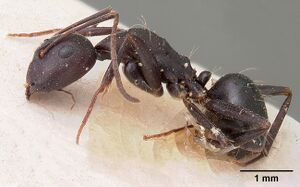  
| |
| Lectotype of Camponotus quadrimaculatus opacata. Worker. Specimen code casent0102107. Photographer April Nobile, uploaded by California Academy of Sciences. | Owned by MSNG, Genoa, Italy. |
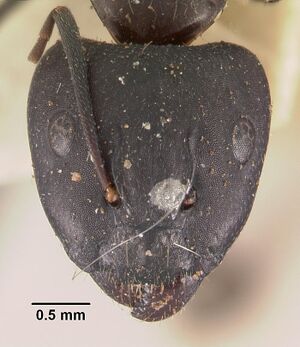    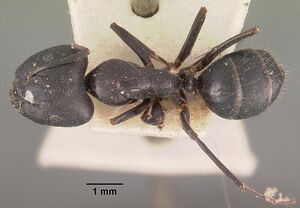 
| |
| Paralectotype of Camponotus quadrimaculatus opacata. Worker (major/soldier). Specimen code casent0102433. Photographer April Nobile, uploaded by California Academy of Sciences. | Owned by MHNG, Geneva, Switzerland. |
 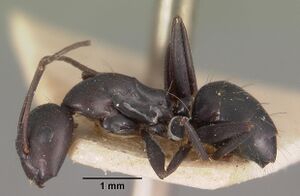  
| |
| Paralectotype of Camponotus quadrimaculatus opacatus. Worker. Specimen code casent0102434. Photographer April Nobile, uploaded by California Academy of Sciences. | Owned by MHNG, Geneva, Switzerland. |
Queen
Images from AntWeb
  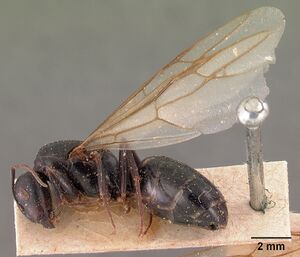  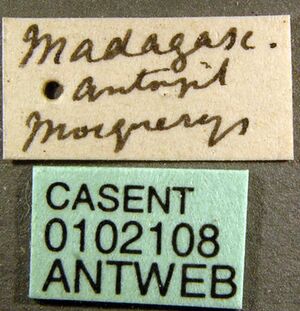
| |
| Paralectotype of Camponotus quadrimaculatus opacata. Queen (alate/dealate). Specimen code casent0102108. Photographer April Nobile, uploaded by California Academy of Sciences. | Owned by MSNG, Genoa, Italy. |
Nomenclature
The following information is derived from Barry Bolton's Online Catalogue of the Ants of the World.
- immaculatus. Camponotus quadrimaculatus var. immaculatus Forel, 1892l: 233 (w.q.) MADAGASCAR.
- Type-material: lectotype minor worker (by designation of Rakotonirina & Fisher, 2022: 111), 2 paralectotype major workers.
- Type-locality: lectotype Madagascar: Forêt d’Andrangoloaka (F. Sikora); paralectotypes with same data.
- Type-depository: MHNG.
- Combination in C. (Mayria): Emery, 1925b: 123;
- combination in C. (Myrmosaga): Rakotonirina & Fisher, 2022: 111.
- Subspecies of quadrimaculatus: Dalla Torre, 1893: 249; Emery, 1896d: 374 (in list); Forel, 1907g: 91; Wheeler, W.M. 1922a: 1047; Emery, 1925b: 123; Bolton, 1995b: 104.
- Status as species: Olson & Ward, 1996: 164; Rakotonirina & Fisher, 2022: 111 (redescription).
- Senior synonym of opacata: Rakotonirina & Fisher, 2022: 111.
- Distribution: Madagascar.
- opaca. Camponotus quadrimaculatus var. opaca Emery, 1899f: 290 (s.w.q.) MADAGASCAR.
- Type-material: lectotype minor worker (by designation of Rakotonirina & Fisher, 2022: 111), 2 paralectotype major workers, 1 paralectotype queen.
- Type-locality: lectotype Madagascar: nr Antongil Bay, 1897-98 (A. Mocquerys); paralectotypes with same data.
- Type-depositories: MSNG (lectotype); MHNG, MSNG (paralectotypes).
- [Junior secondary homonym of Formica opaca Nylander, 1856b: 55.]
- Subspecies of quadrimaculatus: Wheeler, W.M. 1922a: 1047.
- Replacement name: Camponotus (Mayria) quadrimaculatus var. opacata Emery, 1925b: 123.
- opacata. Camponotus (Mayria) quadrimaculatus var. opacata Emery, 1925b: 123.
- Replacement name for Camponotus quadrimaculatus var. opaca Emery, 1899f: 290. [Junior secondary homonym of Formica opaca Nylander, 1856b: 55.]
- Subspecies of quadrimaculatus: Bolton, 1995b: 115.
- Junior synonym of immaculatus: Rakotonirina & Fisher, 2022: 111.
Unless otherwise noted the text for the remainder of this section is reported from the publication that includes the original description.
Description
Worker
Rakotonirina and Fisher (2022):
Morphological measurements: see Appendix 1 and Ratios of morphometric data for majors and minors
Minor With head in full-face view, lateral margins diverging towards almost straight posterior margin; eye slightly convex and small (EL/CS: 0.25±0.01; 0.23–0.28), not interrupting lateral cephalic border, level of its posterior margin located at ca. posterior 1/4 of head (PoOc/CL: 0.26±0.02; 0.22–0.28); frontal carinae wide, posteriorly diverging (FR/CS: 0.32±0.01; 0.30–0.33), distance between them larger than their smallest distance to eye; clypeus with bluntly angulate anterolateral corner and straight anteromedian margin; two apical teeth of mandible normally distant; antennal scape relatively short (SL/CS: 1.28±0.05; 1.19–1.34). Promesonotum evenly convex; posterior portion of mesonotum flat immediately anterior to weakly visible metanotal groove; propodeal dorsum strongly concave medially; junction of dorsal margin of propodeum with declivity bluntly angulate; propodeal dorsum ca. 2 × as long as declivity. Petiole nodiform, its dorsal margin inclined posteriorly and rounding to anterior margin; anterior and posterior faces almost the same height; femur of hind leg rounded axially, not twisted basally.
First and second gastral tergites without a pair of white spots; erect hairs on lateral margin of head absent; two erect hairs present near posterior cephalic margin; antennal scape with appressed hairs only; pronotum and mesonotum with a pair of erect hairs each, posterodorsal angle of propodeum with a pair of erect hairs. Integument shining; body color dark brown; distal portion of leg reddish brown.
Major Characteristics the same as minor worker, except the enlarged head (CS: 2.32±0.12; 2.13–2.46; CWb/CL: 1.00±0.03; 0.96–1.04), with slight concavity of posterior margin; anteromedian margin of clypeus noticeably concave; apical 1/4 of antennal scape extending beyond posterior cephalic margin; robust mesosoma, promesonotum convex, propodeal dorsum straight immediately posterior to metanotum, feebly concave towards declivity, length the same as height of declivity; petiolar node tapering dorsally.
Type Material
Camponotus quadrimaculatus immaculatus
- Syntype workers, Madagascar Andrangoloaka (Sikora); 1 syntype minor worker designated as lectotype, by Rakotonirina & Fisher (2022), AntWeb CASENT0102430 (MHNG).
- Paralectotypes: 2 major workers of same data as lectotype but with specimen codes: CASENT0102429, CASENT0102431 (MHNG) (Andrangoloaka). (Rakotonirina & Fisher, 2022)
Camponotus quadrimaculatus opacata
- Syntype workers and alate queen, Madagascar, Baie d’Antongil (Mocquerys); 1 syntype minor worker designated as lectotype, by Rakotonirina & Fisher (2022), AntWeb CASENT0102107) (MSNG).
- Paralectotypes: 2 major worker and one alate queen of same data as lectotype but respectively with the following specimen codes: CASENT0102106 (MSNG), CASENT0102433 (MHNG) and CASENT0102108 (MSNG). (Rakotonirina & Fisher, 2022)
Taxonomic Notes
When describing C. quadrimaculatus opacata, Emery (1925) did not make any comparative study with C. immaculatus. He stated no morphological characters that separate the former species from the later, and our examination of the syntype specimens of both taxa indicates that morphological variation observed in the former is found across the large geographical distribution of the latter. Hence, there is no doubt to make C. quadrimaculatus opacata under synonymy with C. immaculatus. (Rakotonirina & Fisher, 2022)
References
- Emery, C. 1925d. Hymenoptera. Fam. Formicidae. Subfam. Formicinae. Genera Insectorum 183: 1-302 (page 123, Combination in C. (Mayria))
- Forel, A. 1892o. Les Formicides. [concl.]. In: Grandidier, A. Histoire physique, naturelle, et politique de Madagascar. Volume XX. Histoire naturelle des Hyménoptères. Deuxième partie. Supplèment au 28e fascicule. Paris: Hachette et Cie, pp. 229-280. (page 233, worker, queen described)
- Olson, D. M.; Ward, P. S. 1996. The ant fauna (Hymenoptera: Formicidae) of Kirindy Forest (tropical dry forest) in western Madagascar. Pp. 161-164 in Ganzhorn, J. U., Sorg, J.-P. (eds.) Ecology and economy of a tropical dry forest in Madagascar. Primate (page 164, Raised to species)
- Rakotonirina, J.C., Fisher, B.L. 2022. Revision of the Malagasy Camponotus subgenus Myrmosaga (Hymenoptera, Formicidae) using qualitative and quantitative morphology. ZooKeys 1098: 1–180 (doi:10.3897/zookeys.1098.73223).
- Wheeler, W. M. 1922k. Ants of the American Museum Congo expedition. A contribution to the myrmecology of Africa. IX. A synonymic list of the ants of the Malagasy region. Bull. Am. Mus. Nat. Hist. 4 45: 1005-1055 (see also)
References based on Global Ant Biodiversity Informatics
- Fisher B. L. 1997. Biogeography and ecology of the ant fauna of Madagascar (Hymenoptera: Formicidae). Journal of Natural History 31: 269-302.
- Fisher B. L. 2003. Formicidae, ants. Pp. 811-819 in: Goodman, S. M.; Benstead, J. P. (eds.) 2003. The natural history of Madagascar. Chicago: University of Chicago Press, xxi + 1709 pp.
- Forel A. 1907. Ameisen von Madagaskar, den Comoren und Ostafrika. Wissenschaftliche Ergebnisse. Reise in Ostafrika 2: 75-92.
- Wheeler W. M. 1922. Ants of the American Museum Congo expedition. A contribution to the myrmecology of Africa. IX. A synonymic list of the ants of the Malagasy region. Bulletin of the American Museum of Natural History 45: 1005-1055

